International Journal of Image, Graphics and Signal Processing @ijigsp
Статьи журнала - International Journal of Image, Graphics and Signal Processing
Все статьи: 1157
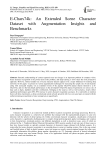
E-Chars74k: An Extended Scene Character Dataset with Augmentation Insights and Benchmarks
Статья научная
Semantic understanding of camera-captured scene text images is an important problem in computer vision. Scene character recognition is the pivotal task in this problem, and deep learning is now-a-days the most prospective approach. However, limited sample-size of scene character datasets appear to be a major hindrance for training deep networks. In this paper, we present (i) various augmentation techniques for increasing the sample size of such datasets along with associated insights, (ii) an extended version of the popular Chars74k dataset (herein referred to as E-Chars74k), and (iii) the benchmark performance on the developed E-Chars74k dataset. Experiments on various sets of data such as digits, alphabets and their combination, belonging to the usual as well as wild scenarios, clearly reflect significant performance gain (20%-30% increase in scene character recognition accuracy). It is noteworthy to mention that in all these experiments, a deep convolutional neural network powered with two conv-pool pairs is trained with the uniform training test partition to foster comparison on equal bench.
Бесплатно
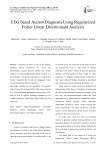
EEG based Autism Diagnosis Using Regularized Fisher Linear Discriminant Analysis
Статья научная
Diagnosis of autism is one of the difficult problems facing researchers. To reveal the discriminative pattern between autistic and normal children via electroencephalogram (EEG) analysis is a big challenge. The feature extraction is averaged Fast Fourier Transform (FFT) with the Regulated Fisher Linear Discriminant (RFLD) classifier. Gaussinaty condition for the optimality of Regulated Fisher Linear Discriminant (RFLD) has been achieved by a well-conditioned appropriate preprocessing of the data, as well as optimal shrinkage technique for the Lambda parameter. Winsorised Filtered Data gave the best result.
Бесплатно
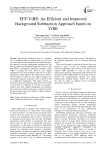
EFF-ViBE: an efficient and improved background subtraction approach based on ViBE
Статья научная
Background subtraction plays an important role in intelligent video surveillance since it is one of the most used tools in motion detection. If scientific progress has enabled to develop sophisticated equipment for this task, algorithms used should be improved as well. For the past decade a background subtraction technique called ViBE is gaining the field. However, the original algorithm has two main drawbacks. The first one is ghost phenomenon which appears if the initial frame contains a moving object or in the case of a sudden change in the background situations. Secondly it fails to perform well in complicated background. This paper presents an efficient background subtraction approach based on ViBE to solve these two problems. It is based on an adaptive radius to deal with complex background, on cumulative mean and pixel counting mechanism to quickly eliminate the ghost phenomenon and to adapt to sudden change in the background model.
Бесплатно
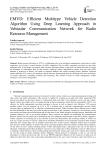
Статья научная
Radio resource allocation in VCN is a challenging role in an intelligent transportation system due to traffic congestion. Lot of time is wasted because of traffic congestion. Due to traffic congestion, user have to miss their important work. In this paper, we propose radio resource allocation scheme so that user can utilize their time by taking the advantage of subscription plan. In this scenario, multitype vehicle identification scheme from real time traffic database is proposed, its history will match in transport database and vehicle travelling history database. Proposed method indicates 95% accuracy for multitype vehicle detection. Subscription plans are allocated to the user on the basis of resource allocation, scheduling, levelling and forecasting. This scheme is better for traffic management, vehicle tracking as well as time management.
Бесплатно
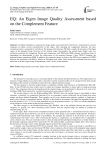
EQ: An Eigen Image Quality Assessment based on the Complement Feature
Статья научная
An Eigen formulation is proposed for image quality assessment IQA. Each block is represented by an array composed of feature vectors (intensity/color at this stage). After attaching the complement feature(s), the auto-correlation matrix is computed for each block. The proposed full reference FR-IQA is simply the deviation of the Eigen values of the degraded image from that of the original image. Interestingly, the second largest Eigen value was sufficient to perform this comparison. Results and comparisons with SSIM and GMSD schemes on different types of degradation are demonstrated to show the effectiveness of the proposed schemes. Using TID2013 database, the proposed scheme outperforms SSIM. In addition, the proposed schemes is closer to the MOS score compared to GMSD; however, the correlation with MOS is inferior as illustrated in the tables. These results are concluded from the average behaviour on all the images using all degradations (with 5 levels) on the database.
Бесплатно
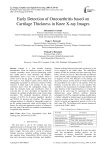
Early detection of osteoarthritis based on cartilage thickness in knee X-ray images
Статья научная
Arthritis is a joint disorder featuring inflammation. There are numerous forms of Arthritis. Arthritis essentially causes joint dis-functioning which may further tend to cause deformity and disability. Osteoarthritis (OA) is one form of arthritis which is mostly seen in old age group. A patient suffering from OA needs to visit medical experts where clinical and radiographic examination is carried out. Analysis of bone structures in initial stage is bit complex. So any vague conclusion drawn from the radiographic images may make the treatment faulty and troublesome. Thus to overcome this we have developed an algorithm that computes the cartilage area/thickness using various shape descriptors. The computed descriptors obtained the accuracy of 99.81% for K-nearest neighbour classifier and 95.09% for decision tree classifier. The estimated cartilage thickness is validated by radiographic experts as per KL grading framework which will be helpful to the doctors for quick and appropriate analysis of ailment in the early stage. The results are competitive and promising as reported in the literature.
Бесплатно
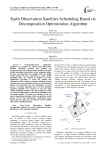
Earth Observation Satellites Scheduling Based on Decomposition Optimization Algorithm
Статья научная
A decomposition-based optimization algorithm was proposed for solving Earth Observation Satellites scheduling problem. The problem was decomposed into task assignment main problem and single satellite scheduling sub-problem. In task assignment phase, the tasks were allocated to the satellites, and each satellite would schedule the task respectively in single satellite scheduling phase. We adopted an adaptive ant colony optimization algorithm to search the optimal task assignment scheme. Adaptive parameter adjusting strategy and pheromone trail smoothing strategy were introduced to balance the exploration and the exploitation of search process. A heuristic algorithm and a very fast simulated annealing algorithm were proposed to solve the single satellite scheduling problem. The task assignment scheme was valued by integrating the observation scheduling result of multiple satellites. The result was responded to the ant colony optimization algorithm, which can guide the search process of ant colony optimization. Computation results showed that the approach was effective to the satellites observation scheduling problem.
Бесплатно
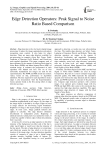
Edge Detection Operators: Peak Signal to Noise Ratio Based Comparison
Статья научная
Edge detection is the vital task in digital image processing. It makes the image segmentation and pattern recognition more comfort. It also helps for object detection. There are many edge detectors available for pre-processing in computer vision. But, Canny, Sobel, Laplacian of Gaussian (LoG), Robert’s and Prewitt are most applied algorithms. This paper compares each of these operators by the manner of checking Peak signal to Noise Ratio (PSNR) and Mean Squared Error (MSE) of resultant image. It evaluates the performance of each algorithm with Matlab and Java. The set of four universally standardized test images are used for the experimentation. The PSNR and MSE results are numeric values, based on that, performance of algorithms identified. The time required for each algorithm to detect edges is also documented. After the Experimentation, Canny operator found as the best among others in edge detection accuracy.
Бесплатно
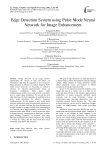
Edge Detection System using Pulse Mode Neural Network for Image Enhancement
Статья научная
Edge detection of an image reduces significantly the amount of data and filters out information that may be regarded as less irrelevant. Edge detection is efficient in medical imaging. Pulse mode neural networks are becoming an attractive solution for function approximation based on frequency modulation. Early pulse mode implementation suffers from some network constraints due to weight range limitations. To provide the best edge detection, the basic algorithm is modified to have pulse mode operations for effective hardware implementation. In this project a new pulse mode network architecture using floating point operations is used in the activation function. By using floating point number system for synapse weight value representation, any function can be approximated by the network. The proposed pulse mode MNN is used to detect the edges in images forming a heterogeneous data base. It shows good learning capability. In addition, four edge detection techniques have been compared. The coding is written in verilog and the final result have been simulated using Xilinx ISE simulator.
Бесплатно
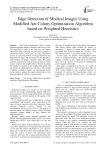
Статья научная
Ant Colony Optimization (ACO) is nature inspired algorithm based on foraging behavior of ants. The algorithm is based on the fact how ants deposit pheromone while searching for food. ACO generates a pheromone matrix which gives the edge information present at each pixel position of image, formed by ants dispatched on image. The movement of ants depends on local variance of image's intensity value. This paper proposes an improved method based on heuristic which assigns weight to the neighborhood. Thus by assigning the weights or priority to the neighboring pixels, the ant decides in which direction it can move. The method is applied on Medical images and experimental results are provided to support the superior performance of the proposed approach and the existing method.
Бесплатно
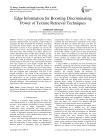
Edge Information for Boosting Discriminating Power of Texture Retrieval Techniques
Статья научная
Texture is a powerful image property for object and scene characterization, consequently, a large number of techniques has been developed for describing, classifying and retrieving texture images. On the other hand, edge information is proven to be an important cue used by the human visual system. Several physiological experiments have shown that, when looking at an object, human eyes explore different locations of that object through saccadic eye movements but they spend more time fixating edge regions. Based on this result, we hypothesize that a better performance could be obtained when analyzing an image (texture images in this case) if the visual features extracted from edge regions are given higher weights than those extracted from uniform regions. To check the validity of this hypothesis, we have modified several existing texture retrieval techniques in a way that incorporates the proposed idea and compared their performance with that of the original techniques. The results of the experiments that have been conducted on three common datasets confirmed the effectiveness of the proposed approach, since a significant improvement in the retrieval rate is obtained for all tested techniques. The experiments have also shown an improvement in the robustness to noise.
Бесплатно
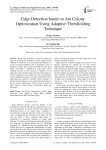
Edge detection based on ant colony optimization using adaptive thresholding technique
Статья научная
Image edge detection is a process where true edges of an image are identified. In past, gradient based methods in which first or second order pixel difference is used to find discontinuities and if magnitude value of gradient is higher than certain threshold then that pixel under observation is identified as edge pixel. These methods are full of error, because in addition to true edges they also find false edges and infect false edges are more in comparison to true edges. To solve such problem, swarm intelligence based ant colony optimization based edge detection method is detailed where numbers of falsely detected edges are very small. The performance of the ant colony optimization (ACO) is done in terms of Peak Signal to Noise Ratio, Performance Ratio and Efficiency.
Бесплатно
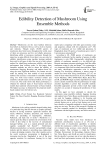
Edibility detection of mushroom using ensemble methods
Статья научная
Mushrooms are the most familiar delicious food which is cholesterol free as well as rich in vitamins and minerals. Though nearly 45,000 species of mushrooms have been known throughout the world, most of them are poisonous and few are lethally poisonous. Identifying edible or poisonous mushroom through the naked eye is quite difficult. Even there is no easy rule for edibility identification using machine learning methods that work for all types of data. Our aim is to find a robust method for identifying mushrooms edibility with better performance than existing works. In this paper, three ensemble methods are used to detect the edibility of mushrooms: Bagging, Boosting, and random forest. By using the most significant features, five feature sets are made for making five base models of each ensemble method. The accuracy is measured for ensemble methods using five both fixed feature set-based models and randomly selected feature set based models, for two types of test sets. The result shows that better performance is obtained for methods made of fixed feature sets-based models than randomly selected feature set-based models. The highest accuracy is obtained for the proposed model-based random forest for both test sets.
Бесплатно
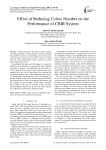
Effect of Reducing Colors Number on the Performance of CBIR System
Статья научная
Taking inspiration from the fact that a human can distinguish only a limited number of colors, reducing the number of colors is an interesting task to be incorpo-rated in image retrieval systems that is based on using only the most discriminative colors, which most of the time yields better results. Accordingly, the main goal of this paper is to study the influence on performance of reducing the colors number contained in images. Accomplishing this task poses an extra overhead on the system, which requires more com-putation time, but, on the other hand, can accelerate the comparison process. Due to their popularity and success, we specifically concentrate this study on histogram in-dexing methods, using both Euclidean distance and histo-gram intersection to assess consequently the distance and the similarity between images. Some simple, pertinent ideas related to the way we compare a pair of images using Euclidean Distance are given in the end of the pa-per, supported by preliminary obtained results.
Бесплатно

Effect of Single and Multiple ROI Coding on JPEG2000 Performance
Статья научная
Images are an integral part of advertisements. Images make the web pages heavy. It increases the response time if the size of the image is large and or available bandwidth is low. The consequence of it is viewer may lose his interest in the particular advertisement if he has to wait for a longer time. Image compression is one of the solutions to this problem. In advertisement images, ROI is of prime importance. Though the context of ROI and background regions are not of prime importance, they cannot be totally discarded. This paper investigates the effect of ROI coding on JPEG2000 performance. It proposes Multiple ROI (MROI) coding for compression of natural and advertisement images at moderate compression ratio. The proposed MROI coding prioritizes ROI codeblocks according to the ROI importance, and contribution of ROI in the specific ROI codeblock. It improves fine-grain accuracy at codeblock level also efficiently utilize the given bit budget with a negligible increase in encoding time.
Бесплатно

Effective Reverse Converter for General Three Moduli Set{(2^n)-1,(2^n)+1,(2^(pn+1))-1}
Статья научная
Residue number system is a non¬-weighted integer number system which uses the residues of division of ordinary numbers by some modules for representing that ordinary numbers. In this paper, the general three moduli set {(2^n)-1,(2^n)+1,(2^(pn+1))-1} based on CRT algorithm is proposed in which “p” is an even number greater than zero. The special case of this set for p=2 which is {(2^n)-1,(2^n)+1,(2^(pn+1))-1} is also described in this paper. Since the dynamic range of this set is odd, some difficult problems in RNS can be easily solved based on this set using parity checking. The proposed reverse converter is better in speed and hardware in comparison to reverse converters in similar dynamic range. Moreover, from the complexity point of view, the internal arithmetic circuits of this moduli set is improved and is less complex than the other sets in similar dynamic range.
Бесплатно

Статья научная
In this work, a 5 state left to right HMM-based Bangla Isolated word speech recognizer has been developed. To train and test the recognizer, a small corpus of various sampling frequencies have been developed in noisy as well as the noiseless environment. The number of filter banks is varied during the feature extraction phase for both MFCC and PLP. The effects of 2nd and 3rd differential coefficients have also been observed. Experimental results exhibit that MFCC based feature extraction technique is better in CLASSROOM environment on the contrary PLP based technique performs better not only in a noiseless environment but also in when AC or FAN noise is present. We have also noticed that higher sampling frequency and higher filter order don’t always help to improve the performance.
Бесплатно

Efficient 2D convolution filters implementations on graphics processing unit using NVIDIA CUDA
Статья научная
Convolution algorithms present a key component and a significant step in image processing field. Despite their high arithmetic complexity, these algorithms are widely used because of their great importance for extracting image properties and features. Convolution algorithms require significant computing time, for that we propose a GPU acceleration of these algorithms by using the programming language CUDA presented by NVIDIA. Since these algorithms consume a lot of computing power, we understand the impact of the implementation of this type of algorithm on the acceleration of processing. GPU implementation present a suitable path to achieve better results than other implementation , for that optimizing time consuming time consuming of applications became an increasingly important task in many research areas. The goal of this work is to try to boost convolution algorithms execution time by adopting GPU implementations to accelerate treatments and to achieve real time constraints.
Бесплатно

Efficient Acoustic Front-End Processing for Tamil Speech Recognition using Modified GFCC Features
Статья научная
Giving suitable input and features are always essential to obtain better accuracy in Automatic Speech Recognition (ASR). The type of signal and feature vectors given as an input is highly essential as the pattern matching algorithms strongly depends on these two components. The primary goal of this paper is to propose a suitable Pre-processing and feature extraction techniques for speaker independent speech recognition for Tamil language. The five pass Pre-processing and three types of modified feature extraction techniques are introduced using Gammatone Filtering and Cochleagram Coefficients (GFCC) to achieve better recognition performance. The modified GFCC features using multi taper Yule walker AR power spectrum, combinational features using Formant Frequencies (FF), combined frequency warping and feature normalization techniques using Linear Predictive Coding (LPC) and Cepstral Mean Normalization (CMN) are investigated. The experimental results prove that the proposed techniques have produced high recognition accuracy when compared with the conventional GFCC feature extraction technique.
Бесплатно

Efficient Algorithm for Railway Tracks Detection Using Satellite Imagery
Статья научная
Satellite imagery can produce maps including roads, railway tracks, buildings, bridges, oceans, lakes, rivers, etc. In developed countries like USA, Canada, Australia, Europe, images produced by Google map are of high resolution and good quality. On the other hand, mostly images of the third world countries like Pakistan, Asian and African countries are of poor quality and not clearly visible. Similarly railway tracks of these countries are hardly visible in Google map. We have developed an efficient algorithm for railway track detection from a low quality image of Google map. This would lead to detect damaged railway track, railway crossings and help to schedule/divert locomotive movements in order to avoid catastrophe.
Бесплатно

